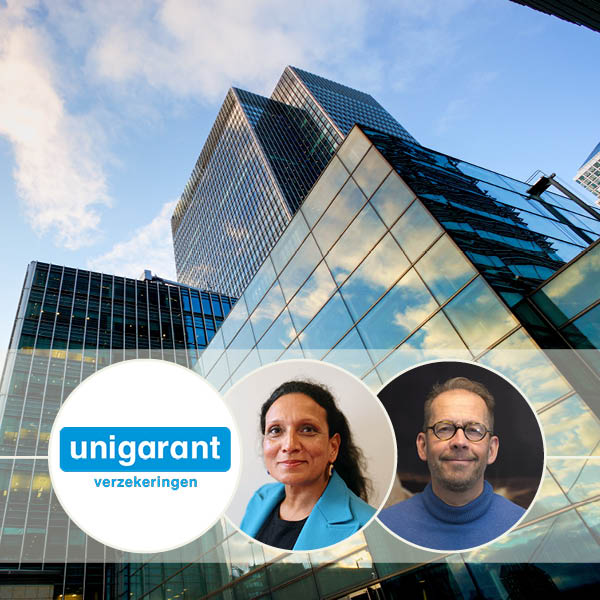We spoke with Guido Evertz, Sustainability Manager, and Pavan Gandhi, ESG Advisor for Investments, from Unigarant NV. (Unigarant NV also acts on behalf of the insurance company UVM Verzekeringsmaatschappij NV; hereafter, the two companies are jointly referred to as ‘Unigarant’). Both companies are part of the ANWB group. As such, themes such as mobility, tourism and recreation are central to Unigarant.
Unigarant originated as a solution to a societal problem – the need for specialist insurance for mopeds. Societal values are central to Unigarant, and these extend to sustainability and the conservation of nature. We discussed the role of Unigarant in relation to these topics and the balancing act between feasibility, reliability and sustainability.
How do you see the role of Unigarant when it comes to the topic of biodiversity?
When it comes to biodiversity, Unigarant has an integrated approach. We see biodiversity as an integral part of our overarching people-planet-profit approach. Due to limited capacity and upcoming regulations, we need to focus our efforts. Following a double materiality assessment, we defined carbon reduction, circularity and social sustainability as our focus areas.
We have not defined biodiversity as a priority topic as such, but our focus areas all definitely link to biodiversity. We are adopting an active approach towards our focus areas, starting with learning about feasible and monitorable targets for biodiversity. We want to prepare ahead of time. That way, when Unigarant is ready to go public about our views on this topic, we’ll be able to define our strategy relatively quickly.
What approach does Unigarant take in its areas of focus?
Our targets are in line with existing policies, such as the Paris Agreement, and with the United Nation’s SDGs 8 (Decent Work and Economic Growth), 12 (Responsible Consumption and Production), and 13 (Climate Action).
To amplify the reach of our responsible investment strategy, we are planning to refine our exclusion and engagement to supplement the ESG screening we have already implemented for our investments. Cooperation with suitable partners is important for our engagement activities. As a medium-sized insurance company, joining forces enhances our message and contributes towards effective investor-investee dialogue.
Besides the increased influence of collective engagement versus single-party engagement, we appreciate the opportunity to gain experience in stewardship practices in topics such as water use and waste production. These are important topics to us and very relevant to ANWB. ‘Recreation’ as a responsible interaction between humanity and nature is central to ANWB, which makes our engagement on nature and biodiversity-related topics consistent with our values.
How does the size of Unigarant affect the risks it can take?
We are a medium-sized investor from the insurance sector, with a low-risk profile. As such, we have limited room for equity or illiquid investments. Reliability is a key feature of our identity as an insurer. In line with that, any goals that we set must be feasible. This means that we aim to set achievable goals and take a pragmatic approach. Simultaneously, climate change and biodiversity loss are also a risk in themselves. Transition risks, in particular, are increasingly relevant in the light of sustainability and biodiversity.
New regulations have made sustainability an integral part of discussions on risks, returns and asset allocation. In this manner, social return and risk avoidance have become an integral part of investing.
How do you decide what is feasible for you?
Our decisions are made according to the requirements of the Solvency II framework and the available ESG screening instruments. We pick the instruments that are investable, accessible and liquid. For instance, to be successful in impact investing, we have picked green bond strategies and sustainable equity indexes. To go beyond that, we would need more financial space and expertise in our operational set-up to manage the associated risks. We set the risk budget based on our own risk appetite, and then see what room there is for other goals within the risk budget.
We certainly have ambition when it comes to sustainability, but we do not want to overpromise what we are capable of. That is why our focus is currently on complementing our ESG investing strategy by further calibrating the implementation of exclusion, engagement and voting instruments, to increase the deliberate thematic impact of our investment portfolio. These are instruments that we can apply independently of the risk budget. We believe that many ways lead to Paris and Montreal.
What would help you in the process of becoming more nature-positive?
It would be great if there was more attention paid to creating non-numerical indicators on sustainability, as an upfront measure to show companies’ willingness to act more sustainably, in terms of goals and follow up actions. Right now, sustainability mainly takes place in the non-financial reporting sphere, where there is an emphasis on quantifying sustainability outcomes and measurable indicators. There is little focus on measuring ambitious commitments, however. We find this equally important, as long as the announced commitments are acted on accordingly.
The willingness of boards to speak out about their sustainability ambitions and how they intend to implement them is at least as essential as measuring the effectiveness of their strategies using measures that can be captured in numbers (such as CO2 emissions). This is a matter of measuring at the ‘front’, i.e. the ambition level, or at the ‘back’, i.e. the success of implementation. Currently, ESG performance measurements by investors and businesses are carried out retrospectively, by measuring sustainability indicators such as water use and carbon emissions.
However, if we want long-term returns on sustainability, businesses must be publicly open about their intentions and set good targets. This is an important factor in our engagement trajectories as well. In other words, sustainable investing and reporting on sustainability should be about more than just measuring carbon emissions; it should also be about good governance.

